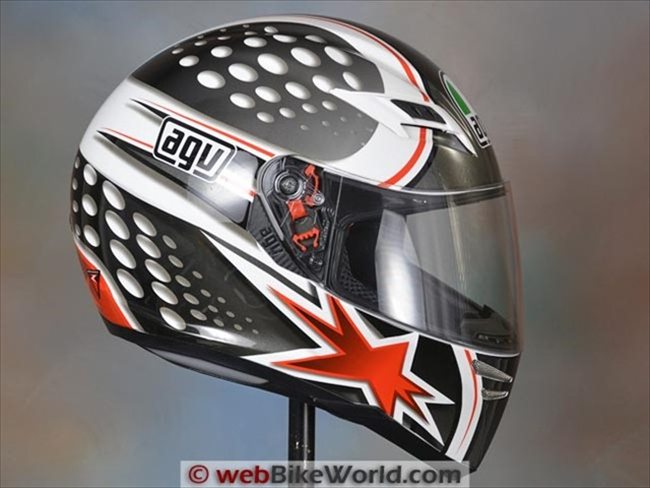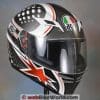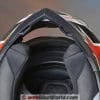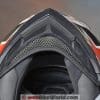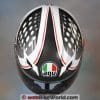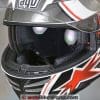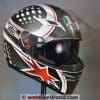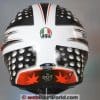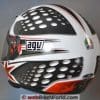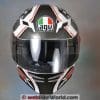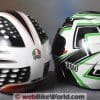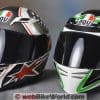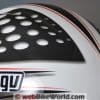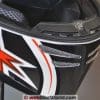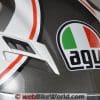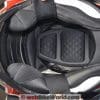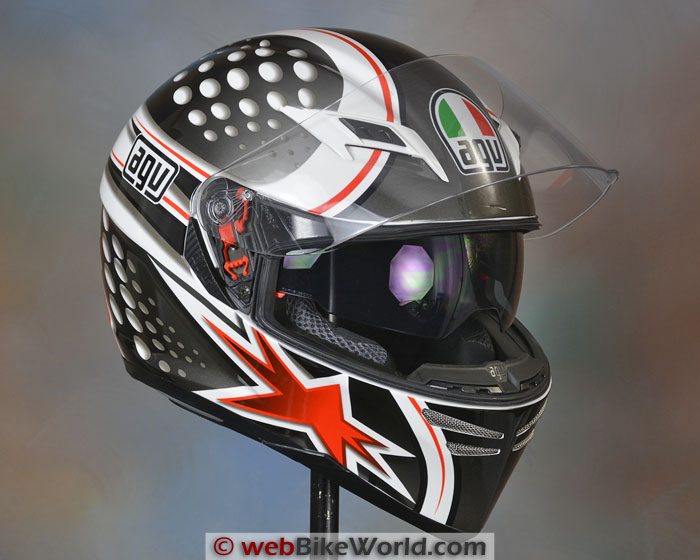The new AGV Skyline slides into the “GT” category of the AGV expanded 2014 helmet lineup.
The Skyline differs very little from the AGV Horizon (review).
Both helmets have a very similar appearance, with the newer generation AGV styling theme readily apparent.
Both helmets have an internal sun shade, which leaves two main differences.
First, the Skyline has a “micro-lock” chin strap while the Horizon gets a double D-ring retainer.
And the most important difference is that the Horizon has a rear exhaust vent with spoiler, while the Skyline has no rear or side vents at all.
The similarities can make for a difficult choice between the two; both are good-looking and have a solid countenance, courtesy of their fiberglass and carbon fiber composite shells.
There is one more difference, however; the Skyline carries a list price $50.00 shy of the Horizon. And the Horizon is listed as ECE 22.05 and DOT, while the Skyline is DOT only in the U.S.A.
Both are very well made helmets, however, with a comfortable fit for “Neutral” to “Slightly Narrow” head shapes.
The choice pretty much distills down to a preference for quick release vs. D-ring and better upper ventilation on the Horizon.
I’m partial to air flow and a D-ring, so it’s the Horizon for me but…50 bucks is 50 bucks, and the Skyline offers pretty much the same experience. As I said, It’s a very tough decision.
By the way, both helmets (and the AGV Numo Evo reviewed recently) also feature the new AGV customizable face shield opening system, which allows the owner to change the number of detents with different inserts.
We somehow missed describing this feature twice — once in the Numo Evo review and before that in the Horizon review, but we’ll cover it here and we’ve also put together a separate video illustrating the AGV quick-change visor detent process.
Background
AGV has been releasing helmets faster than we can review ’em! There are now 11 different helmets in the Italian company’s full-face lineup, including two flip-ups (Numo Evo and Miglia II).
With that many helmets, there’s bound to be some hair-splitting and niche-filling.
For example, the Skyline looks (and is) very similar to the Horizon, with minor differences between the two making a choice very difficult. In a good way, that is…
AGV Skyline Paint, Graphics and Overall Quality
We were impressed with the overall quality, paint and graphics on the AGV Horizon (review) and that’s a ditto for the Skyline.
It would be difficult to choose between the two based on graphics alone.
The Horizon has that cool-looking faux carbon fiber honeycomb graphic (and our “Racer Green” version really pops), while the Skyline in the “Psycho” graphics has a 3D-look grid on both sides that really does look three-dimensional.
The fit and finish of all the moving parts on the Skyline is outstanding and the helmet has a solid feel, courtesy of its stiff composite shell made from fiberglass and carbon fiber.
The helmet’s interior is also very nice and the padding seems to have a slightly different composition and texture than the Horizon, although I’m not sure if this is actually the case.
The Skyline’s padding feels very thick and firm and the fit around the bottom of the helmet is snug and encompassing, which helps keep noise levels subdued.
Like the Horizon, the chin vent and top vents of the Skyline have a solid snap-open feel and the new “corporate” AGV flush chin vent system is about the best in the business.
The quality of the internal sun shade on our Skyline is also very good, so we must have had a one-off issue with the sun shade in our Horizon, which had a few optical clarity flaws.
Score: I’ll give the AGV Skyline an “Outstanding” rating for excellent overall quality. See the Summary Table at the bottom of the page for a description of our rating system.
AGV Skyline Helmet Fit, Internal Shape and Liner
The Skyline and Horizon have the similar AGV family internal shape that I’d call “Neutral” to “Slightly Narrow”.
Our Horizon was ordered in size XL but I decided to try the size L for the Skyline, and it actually fits my almost XL “Round” head shape quite well (and better than the XL Horizon).
The size L is listed as fitting the standard (for size L) 59-60 cm head but my 60.5 cm in-between large and extra-large sized head fits pretty nicely, although the cheek pads are just a touch too tight. I may order a set of slightly thinner cheek pads and it should be perfect.
The Skyline’s padding is especially noteworthy; it feels thick and firm and it gives the helmet a very protective feel.
A half-hour into my first ride with the Skyline got me thinking that it would be the helmet I’d choose for a long journey and my opinion hasn’t changed since.
The removable liner is the AGV “Dry-Lex type with sanitizing treatment” and although the weather has remained cool, I’m betting the liner will feel comfortable if and when summer ever arrives.
The ear pockets are generous and like the Horizon, there’s a neoprene-type plug in each to cover the speaker cutout.
The back of the chin bar is molded to accept the special microphone for the AGVoice communication system, just like the Horizon, and a rubber plug with the AGV logo fills the hole when it’s not in use.
The “AGVoice” intercom module, speakers and microphone apparently install without having to add wiring, if our understanding is correct.
Third-party intercom systems should fit the helmet, but without using the built-in wiring (although perhaps some clever owner can hack it together).

More information on helmet fit can be found in the webBikeWorld Motorcycle Helmet FAQ page, along with the chart that lists the helmet weights of webBikeWorld reviewed helmets and also by shape on the webBikeWorld Motorcycle Helmet Shapes page.
Score: I’ll give the AGV Skyline an “Outstanding” rating for shape, comfort and padding with a very nice liner and padding that should work well in hot weather.
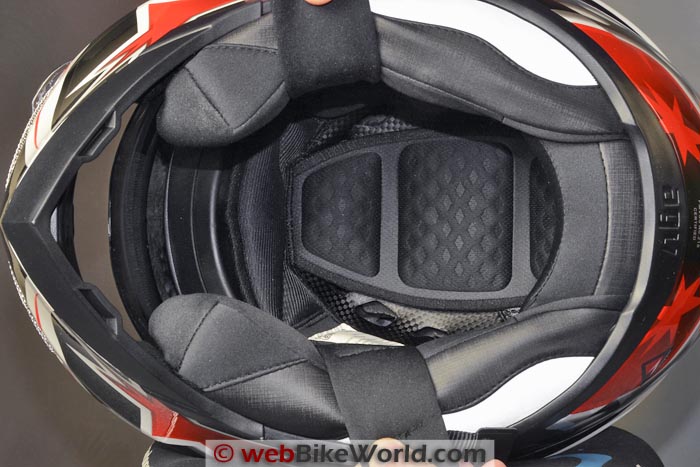
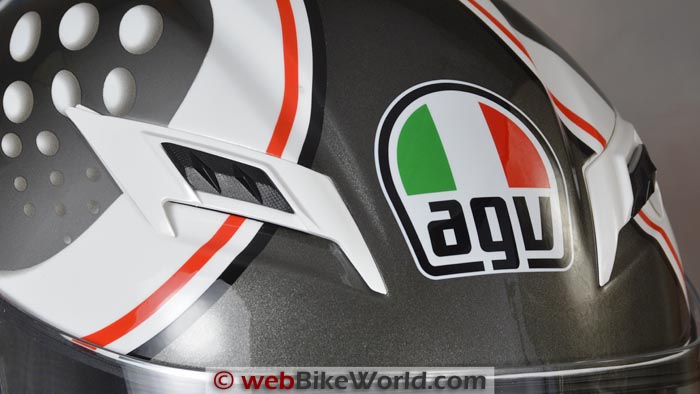
AGV Skyline Face Shield, Sun Shade, Eye Port and Outward Visibility
The size large Skyline appears to have a slightly smaller face shield or eye port than the XL Horizon, although I didn’t measure the two. Overall the outward visibility is good in both the horizontal and vertical planes.
The face shield is optically correct and the optical quality of the internal sun visor of the Skyline is better than our Horizon.
The internal sun shade rotates down to remain out of the rider’s line of sight, so it is a useful feature.
Like the Horizon, the AGV Skyline face shield is a model of simplicity and user-friendliness when it comes to removal or replacement.
The procedure is illustrated in the video below; pull down on the ring to remove the face shield and simply press the face shield back in to install it. The system works really well but there is no face shield lock on the Horizon, although it seals tight when closed.
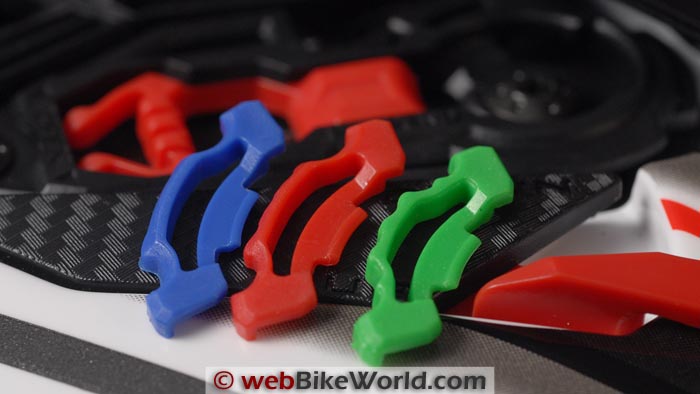
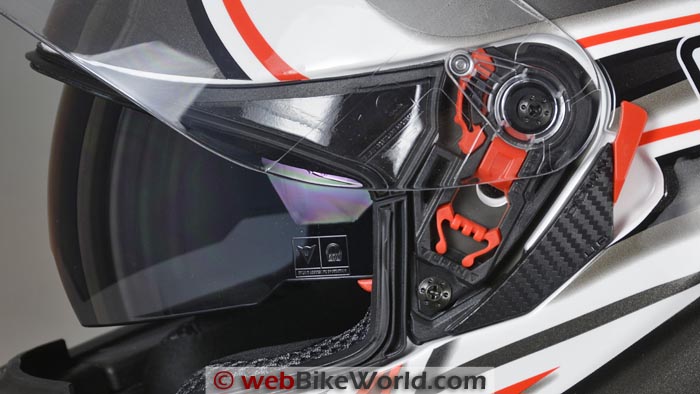
AGV Customizable Visor Opening System
We somehow missed this feature in the AGV Horizon and Numo Evo reviews and AGV didn’t make a big marketing push about it (at least that we were aware of), so apologies for that.
The “customizable opening system” (which needs a catchy marketing name) includes 3 different plastic inserts in the helmet box, which are semi-hidden in the plastic bag that holds the owner’s manual and other documentation.
The owner can swap out the inserts to change the visor or face shield opening positions.
The inserts come in different colors, depending on the helmet, to compliment the helmet’s graphics and color scheme and they have different detent patterns molded into the upper portion.
The three inserts include the basic “touring” insert with 4 detents; a “city” insert that adds a small first defogging position; and a “race” insert with two detents, open and closed.
It’s an interesting idea, although the curvature of the thin plastic has some give, which makes some of the detents feel less firm than I’d like.
Also, the “race” detent is sort of a moot point, because neither the Skyline, Horizon or Numo Evo are racing helmets and they don’t have a visor lock anyway.
An insert with a solid first defogging position, then maybe a half-way open position and then full open would be more useful, in my opinion.
The “city” detent, with the defogging detent, is the most useful for street riders.
However, that first defogging position detent isn’t firm enough, so the face shield doesn’t readily hold the small first defogging position and the detent feels a little loose, which makes the face shield feel a bit loose also when it’s shut.
But AGV gets an “A” for effort on this. Perhaps a firmer plastic or a less “slippery” plastic than is currently used (it feels like nylon) or more sharply molded detents would be better.
Since we missed this feature when it was introduced on the first two AGV helmets, to make amends, we’ve created a short video that describes the inserts and demonstrates how to install them, available through the following links:
AGV Customizable Opening System (YouTube) | AGV Customizable Opening System (Vimeo Pro)

Score: The AGV Skyline visibility is better than average and gets a score of “Excellent”.
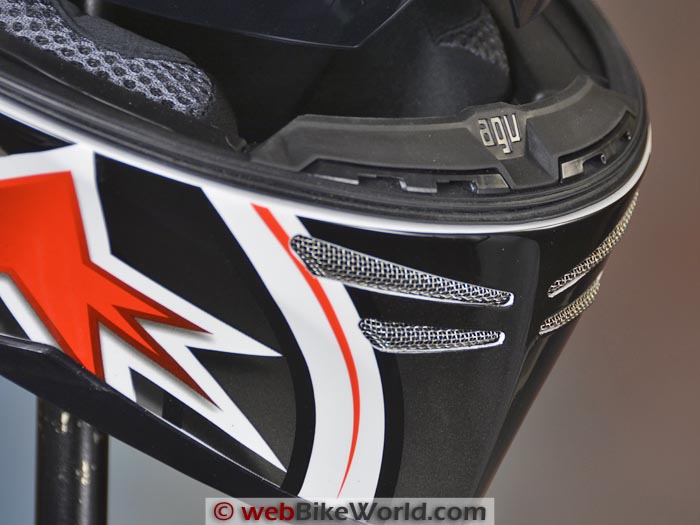
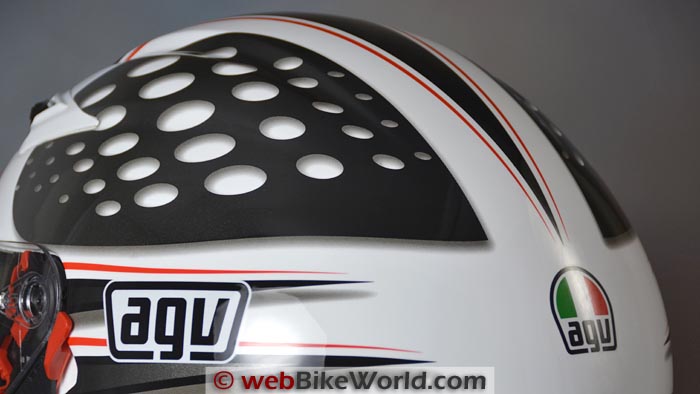
AGV Skyline Ventilation and Air Flow
The new AGV flush mount chin vent system found on the Horizon and Skyline are almost identical, other than slight differences in the mesh that covers the vents on the outside of the chin bar.
The system works really well, with four large slots flowing air directly through the chin bar.
The switch to open or close the vent is hidden up underneath the chin bar.
It solidly opens or closes the vents and when the chin vent is open, it flows a lot of air. Some air bleeds off towards the top of the chin bar and on to the back of the face shield.
The top vents on the Skyline are also very similar to the vents on the Horizon, with hard plastic sliders on the former and rubberized sliders on the latter. The two vents open independently.
But the efficiency of the upper ventilation is the main difference between the two helmets.
In the Horizon, the upper portion of the helmet liner and the EPS is molded and cut to allow the air to flow on to the top of the head and the helmet has a rear exhaust vent system.
The Skyline has four large channels down through the EPS to direct the air flow, but no exhaust out the back.
The Numo Evo does without a rear exhaust vent also, and this trend is one we’re not fond of.
Motorcycle helmet ventilation is problematic to begin with and removing the ability to exhaust the air in the low pressure stream makes the job that much more difficult.
The absence of the exhaust makes a noticeable difference in the upper ventilation performance of the Skyline. The vent system should flow a generous amount of air on to the rider’s head, with the big channels in the top of the helmet.
But it doesn’t, and we think it’s because there’s a pressure buildup inside the helmet with nowhere for the incoming air to go. Both the Skyline and the Numo Evo sorely need a rear exhaust vent system.
In addition, the top vents on the Skyline generate some whistling wind noise, whether open or closed, and we think this may be due to the air pressure building up at the vents with nowhere to go inside the helmet.
However, overall the helmet noise in the Skyline does seem lower than average.
Since the top vents on both the Skyline and Horizon (and the Numo Evo) are nearly identical in design, one ride with the Horizon shows that an exhaust vent is needed to gain maximum benefit of the system.

Score: I’ll rate the ventilation system of the AGV Skyline as “Outstanding” for the chin vent and “Below Average” for the top vents.
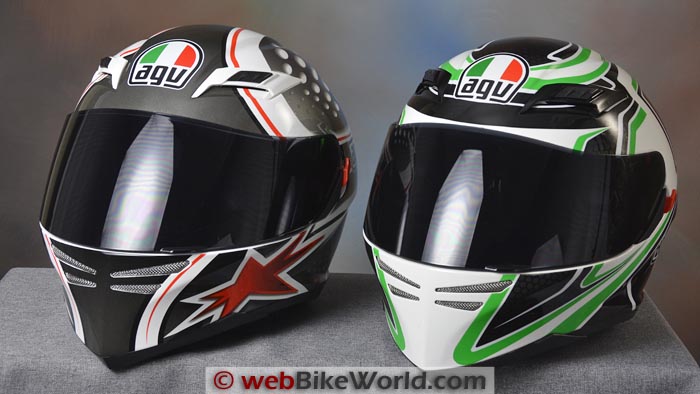
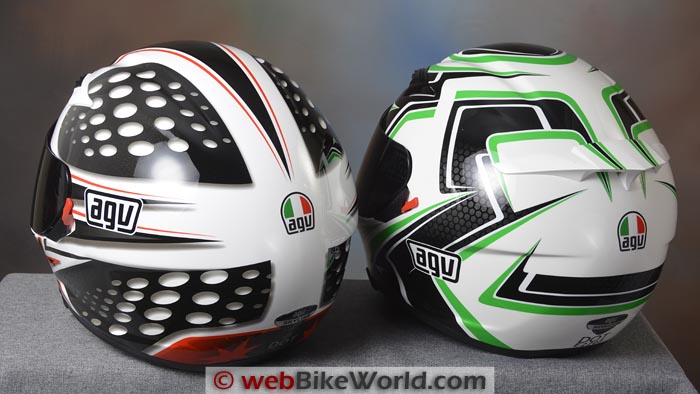
AGV Skyline Sound Levels
The excellent build quality of the Skyline and the flush-mounted chin vent, along with the shape of the helmet help to keep noise levels low.
When the top vents are either open or closed, there is some wind noise but the smooth air flow around the chin and face shield and sides of the helmet, with good control at the bottom, help to keep the wind noise generally low.
Both the Horizon and Skyline have good control for the wind noise around the bottom part of the helmet.

Note that our helmet evaluations are a combined effort of several riders over time on different types of motorcycles with and without windscreens.
Evaluators wear correctly fitted, high quality ear plugs (even when evaluating motorcycle intercom systems).
Always protect your hearing when riding a motorcycle. See the wBW Earplug Reviews for more information on choosing and wearing earplugs.
Note also that perceived noise levels will vary, depending on the individual.
Noise can be caused by many factors, including helmet fit, the type of motorcycle and windscreen, wind speed and direction and even the rider’s clothing.
For more information on helmet noise, visit the wBW Motorcycle Helmet Noise page.
Score: I’ll give the AGV Skyline an “Outstanding” rating for better than average noise control.
Helmet Weight
This size Large AGV Skyline weighs 1661 grams (3 lbs., 10-5/8 oz.). The Horizon in size XL weighs 1685 grams (3 lbs., 11-3/8 oz.), both good considering an internal sun visor is included.
The very comfortable liner and excellent fit, along with the thick padding and the aerodynamics help to make the helmet feel comfortable and nicely balanced.
Note that all of the helmets reviewed on webBikeWorld have been weighed and the weights are available on the wBW Motorcycle Helmet Weights page, along with a chart that lists the helmets by weight and shape on the wBW Motorcycle Helmet Shapes page.
Score: I’ll give the AGV Skyline an “Excellent” rating for its relatively low weight and good balance.
Miscellaneous
The other main difference between the Horizon and the Skyline is that the former has a double D-ring for the chin strap retainer, while the Skyline has a micro-lock “quick release” type.
The padding is adequate and the length is good.
The Horizon meets both DOT and ECE helmet safety standards and the Skyline is marked as DOT only but in an update, AGV said the Skyline is also DOT and ECE approved.
Conclusion
The new AGV Skyline is basically a less expensive take on the Horizon.
Choosing one or the other is a bit of a tossup; the Horizon has better upper ventilation and a simpler, lighter, easier-to-use and proven double D-ring chin strap retainer.
Both helmets are beautifully made and have a quality feel.
The color and graphic choices are beyond reproach and the extras include the internal sun shade, chin curtain, customizable detent system and the micro-lock chin strap retainer on the Skyline.
I’m partial to the Horizon, but if you’re looking to save 50 bucks and you want the composite shell and most of the other features of the Horizon, the Skyline is a worthwhile choice.
| wBW Review: AGV Skyline Helmet | |
|---|---|
| Manufacturer: AGV SpA | List Price (2014): $299.95 (Solids) to $359.95 (Graphics). |
| Colors: White, black or two graphics with colors. | Made In: China |
| Sizes: S-2XL Shell Sizes: 2 | Review Date: April 2014 |
|
Rating Scale is subjective: Unacceptable, Poor, Neutral, Very Good, Excellent, Outstanding.
|
|
Owner Comments and Feedback
See details on submitting comments.


